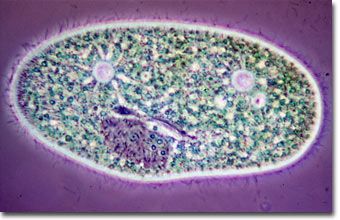Spike (M.I.) Walker
Ciliate Protozoan
English photomicrographer Spike (M.I.) Walker has been a consistent winner of the Nikon Small World competition for many years and has published many articles and a book about microscopy. Featured below is a photomicrograph of a living ciliate protozoan, Paramecium bursaria.

|
Phase contrast photomicrograph of Paramecium bursaria. A living specimen of this ciliate protozoan was trapped under a cover glass and slightly compressed by carefully removing water from the edge of the cover with a strip of filter paper. Note the hair-like cilia with which it swims, and also the green symbiotic cells of Zo÷chlorella. Careful observation of the photomicrograph reveals a macronucleus with micronucleus in a notch, the protozoan's gullet (grey line in front of the micronucleus), and two contractile vacuoles with radiating feeder canals. The objective was a 40x/0.65 NA achromat with a Reichert Zetopan microscope. The camera system was a Reichert Zetopan with an Exacta camera body. A Zeiss microflash illumination was utilized to make the 0.5 micro second exposure. The film was Kodachrome 25. (125x) |
A well-known visitor to the classroom microscope, this slipper-shaped ciliate is commonly found in freshwater ponds around the world; only one species lives in marine waters. They are easily cultivated in the laboratory by allowing vegetable matter to stand in water for a few days. The common species Paramecium caudatum is widely used in research.
The organism is covered with cilia, minute hairlike projections that are used in locomotion and during feeding. When moving through the water, a paramecium follows a spiral path while rotating along the length of the body. When it encounters an obstacle, it backs away at an angle and starts off in a new direction. They feed mostly on bacteria, sweeping them into a funnel-shaped gullet with their cilia, but feed on other small protozoans as well.
A paramecium has a large nucleus called a macronucleus, which is essential for its survival, and one or two small nuclei called micronuclei, which are essential for sexual reproduction. Reproduction is usually asexual by binary fission. Occasionally, two organisms will exchange nuclear material through conjugation, a form of sexual reproduction. In rare instances, an organism will go through endomixis, a process of periodic nuclear reorganization that occurs only in ciliated protozoans.
